| Time* | Event |
|
May 26 |
|
| The US carriers Enterprise and
Hornet arrive at Pearl Harbor for immediate refueling after their
aborted attempt to join the battle in the Coral Sea. They are ordered
to move out to Midway when replenishment is completed. |
|
|
May 27 |
|
|
Admiral Nagumo’s carrier force (Akagi, Kaga, Hiryu and Soryu) left port for Midway. Escorting the force were two battleships, three cruisers and a swarm of destroyers. The victors of Pearl Harbor, the scourge of the South Pacific and Indian Ocean, headed to destiny. The US carrier Yorktown, still showing the scares of battle from the Coral Sea battle, enters Pearl Harbor’s dry-dock to undergo emergency repairs. |
|
|
May 28 |
|
|
Task
Force 16 sets sail for Midway Island to meet the Japanese invasion
force. The force of two carriers (Enterprise and Hornet), six cruisers
and nine destroyers set sail to do battle with nearly 90 Japanese
warships. The slow battleships were intentionally left behind and
ordered to protect America’s west coast. Nimitz had fully grasped the
concepts of modern speed over firepower and the supremacy of airpower
in naval action, something his counterpart Yamato was yet to learn. On
the other side of the Pacific, the Japanese Midway attack force sets
sail. Included in the massive armada is the new battleship Yamato. This
ship, the most powerful battleship in the world, carried 18” guns. The
fleet includes two other 16” battleships and a swarm of cruisers and
destroyers, as well as troop transports and support ships. |
|
| May 30 | |
| In an amazing feat of dockyard efficiency and perseverance, Yorktown, still showing the scares of battle and showing the signs of hasty repair left Pearl Harbor to join the fleet at Midway Island. Task force 17 consisted of Yorktown, 2 cruisers and 5 destroyers. | |
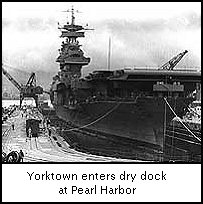
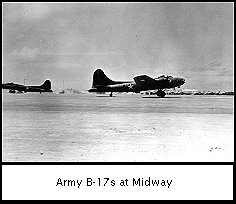 |
|
| June 3 | |
| 0900 | PBY "Catalina" flying boats made contact with the Japanese support group 700 miles west of Midway. |
| 1520 |
Nine B-17s from Midway made a high level bombing attack against the support group, now 570 miles from Midway. |
| June 4 | |
| 0130 |
Four Catalina's flying boats attack the Japanese support force - they missed. |
| 0430 | Both sides launch scouts. Yorktown and
PBYs on Midway Island provide the service for the Americans while the
Japanese use carrier borne as well as surface ship based sea planes to provide the coverage. The Japanese also launch their Midway strike (36 Vals, 36 Kates, 36 Zeroes). |
| 0445 | The Midway strike flight finishes
launching and heads for the island while Nagumo brings his Kate torpedo
bombers on deck prepared for a launch against the American carriers if
spotted. |
| 0500 | The seaplane scout from the Japanese
cruiser Tone was delayed in launch due to a faulty catapult but was
launched only a half hour late. |
| 0520 | Catalina's spot Nagumo's carriers. The
Japanese Zero fighters pursue the Americans and begin a game of "cat
and mouse" among the clouds above the Japanese fleet. |
| 0545 | Catalina scout plane makes its first
brief report on spotting the enemy fleet but details were not yet
available. |
| 0555 | Midway radar reports that it has
identified the incoming enemy air raid and scrambles all planes still
on the island. |
|
|
|
| 0600 |
All planes on Midway Island have taken
off, some stay to provide fighter protection while others proceed to
the recently spotted Japanese ships. |
| 0605 | A detailed report from the Catalina
scout plane is sent. Yorktown's carrier based scout planes are
recalled. Enterprise and Hornet steer for the enemy fleet and prepare
to launch an all out strike at maximum range. |
| 0615 |
Twenty antiquated F2F Brewster
Buffalos and six modern F4F Wildcat Marine fighters meet the Japanese
air raid heading for Midway. The short melee ended with the downing of
several of the Japanese bombers, and heavy losses to the Marine
fighters (17 shot down and 7 badly damaged) |
| 0635 | The Japanese raid over Midway begins. |
| 0700 | The Japanese raid over Midway is completed and the flight commander, Lt. Tomonaga, reports that a follow-up raid is needed to finish off the island's defenses. |
| 0705 |
US aircraft from Enterprise and Hornet
are ordered to make an all out strike at the Japanese carriers. The
raid consists of 29 torpedo bombers, 67 dive bombers and 20 escorting
fighters. It would take an hour to launch and assemble the groups for
the raid. |
| 0710 |
Four B-26's armed with torpedoes and
ten Marine torpedo bombers from Midway made contact with the Japanese
carrier force and attacked. Japanese fighters intercepted the Americans
and shot most of them down before they could launch their weapons. None
of the attacks succeeded in hitting a target. |
| 0715 | Nagumo, having just seen an attack on
his group from Midway and not yet having any contact reports from his
scout planes, decides to take the Kate torpedo bombers below deck to
the hangars and have them rearmed with high-explosive bombs for a
follow-up attack on Midway. |
| 0730 | The Japanese scout plane from 'Tone'
(the one which was delayed by 30 minutes) reports that it has spotted
an enemy formation of 10 ships but neglects to provide information
regarding composition (carriers in particular). Nagumo suspends the
rearmament of the Kate's until clarification of the spotting report can
be made. |
| 0750 | Concerned about lack of fuel,
Enterprise orders her dive bombers to proceed to the target and the
other flights would proceed when assembled. Contact between the various
groups was lost almost immediately. |
| 0755 | Sixteen Marine dive bombers from
Midway attack Nagumo's carriers. All available fighters are sent aloft
to confront the new threat |
| 0810 |
The Japanese scout plane from 'Tone'
reports that it has spotted an enemy formation of 5 cruisers and 5
destroyers. Relieved that there were no carriers in the force, but the
report is short lived as a new American attack is reported to be
heading in. |
| 0815 |
Fifteen B-17's, flying at 20,000 feet
make a high altitude bombing run at Nagumo's carriers, no hits are
achieved. |
| 0820 | The Tone's scout plane reports that it
has spotted an American carrier with the group previously spotted. |
| 0820 | Eleven Marine bomb armed scout planes
from Midway attack Nagumo's carriers |
| 0825 |
The US submarine Nautilus launches
torpedoes at one of the battleships escorting Nagumo's force but the
Japanese are able to dodge the pathetically slow American torpedoes. |
| 0830 | Yorktown commences launching strike
aircraft (17 dive-bombers, 12 Torpedo bombers) |
| 0835 |
The Midway strike force, low on fuel and with some seriously damaged aircraft, makes contact with the Japanese carrier force and requests immediate landing. Nagumo orders his bombers rearmed with torpedoes and armor-piercing bombs for a strike on the US carriers. |
| 0840 | The American strike groups begin to
arrive in the area that they assumed the Japanese carriers would be
only to find empty seas. Unknown to the strike leaders, Nagumo had
changed course to the Northeast to close with Yorktown. Hornet's dive
bombers headed Southeast (toward Midway) into empty sea. The two
torpedo bomber groups spotted smoke on the northern horizon and headed
for that. Enterprise's dive bombers headed Northwest (back along the
expected path of the Japanese carriers). The strike was now completely
uncoordinated. |
| 0920 | The Japanese, their strike aircraft rearmed, on deck begin fueling and preparations for takeoff, receive report that an American raid is coming in. |
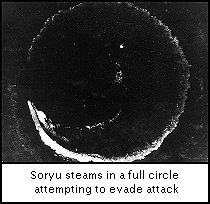
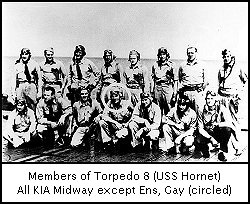 |
|
| 0925 |
Hornet's torpedo bombers head into the attack. They were not protected by fighters and in order to deliver their weapons, they had to fly low and slow. The patrolling Japanese fighters pounced on the easy targets and one-by-one, each of the American planes was shot down. Only one man, Ensign George H. Gray survived the onslaught. Through the remainder of the day, he would cling desperately to a seat cushion not daring to inflate his raft for fear that it would be spotted by the Japanese fleet which surrounded him. |
| 0940 | The Enterprise's torpedo bombers
attack the Japanese carriers. The defending Zeroes and anti-aircraft
fire wrecked havoc among the attacking aircraft. |
| 0945 |
Enterprise's dive bombers sight a Japanese destroyer (which had been tasked to drive off the Nautilus and was now returning to the carrier group). The group commander decided to follow the ship's heading and soon after spotted the Japanese carriers. |
| 1000 | The Yorktown's torpedo bombers attack
the Japanese carriers. The defending Zeroes and anti-aircraft fire
wrecked havoc among the attacking aircraft. |
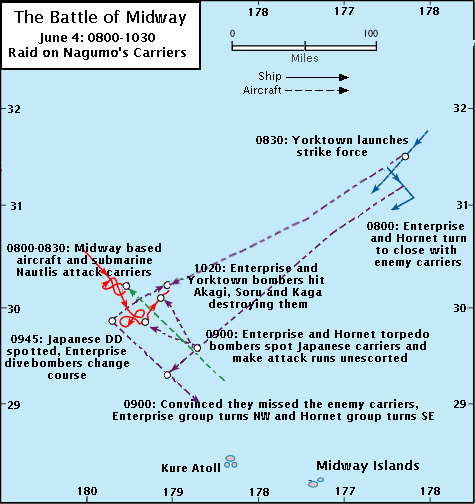 |
|
| 1020 | The last group of American attack
aircraft, a combination of Yorktown and Enterprise dive-bombers,
arrived independently over the Japanese carriers. The Japanese fighter
protection had been spent destroying the previous waves of attackers
and the carriers stood defenseless against the American raiders. The
Japanese decks were at their most vulnerable, still crammed with fully
armed and fueled strike aircraft. All Admiral Nagumo could do was watch
the destruction of his once proud fleet.
Akagi, Nagumo's flagship, was struck amidships. The bomb penetrated the deck and detonated torpedoes in the hanger. This destroyed the flight deck and started numerous fires. A second bomb hit among the planes on deck starting a massive fire that engulfed the ship. Akagi was doomed. Nagumo transferred his flag from the stricken ship minutes later to the cruiser Nagara. Kaga received four bomb hits. One blew up a fuel truck on deck which threw burning gas over the island, incinerating everyone on the bridge. The other three bombs hit the packed aircraft and the entire flight deck was ablaze. The inferno was out of control in minutes. Yorktown's bombers hit Soru, striking with three bombs. One bomb penetrated to the hanger deck and caused massive damage while the others hit among the planes on deck starting fires which spread throughout the ship in minutes. In the span of 5
minutes, the Japanese carrier strike fleet, the dreams of victory and
empire were engulfed in flame and destruction. |
| 1100 | Yorktown launches scout planes to search west for the survivors of the Japanese "carrier" group. Meanwhile Hiryu launches her surviving torpedo planes and half her escorts for a raid on the American carriers. |
| 1150 | The American strike force lands back at their carriers and reports that one Japanese carrier (Hiryu) survived. |
| 1155 | Hiryu launches her torpedo planes and
the last of her fighters to attack the American carriers. |
| 1200 |
Yorktown radar picks up an incoming
raid. The raid consisted of 18 Val dive bombers escorted by Zeroes.
Yorktown's fighters hit the attackers, killing 10 of the bombers. Two
more fell to anti-aircraft. However, the remaining Japanese airmen,
showing the skill and bravery that had brought them this far delivered
their bombs with devastating effect. One bomb hit the flight deck,
tearing a huge hole in the wooden deck. A second bomb, hit the funnel.
A third bomb penetrated four decks and blew up deep in the bowels of
the ship. Fires started which threatened the ships magazine and fuel
bunkers. The funnel hit extinguished the engines and speed dropped as
the boilers lost draft. |
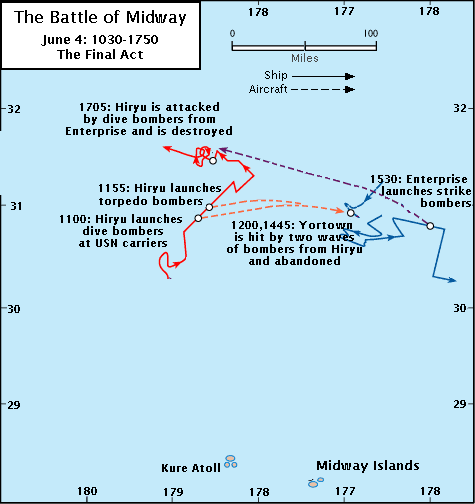 |
|
| 1235 |
Yorktown's flight deck is repaired, but her engines come to a stop and she is dead in the water. Enterprise begins landing Yorktown aircraft as Japanese raid has disabled her. |
| 1325 | Yorktown repairs her plant and begins
refiring her boilers. She is able to make 20 knots. |
| 1350 | Yorktown's fires, save for the fire
below deck, are under control and flight operations recommence. |
| 1400 |
Yorktown's radar reports another
incoming raid. Fighters intercepted the Japanese torpedo planes and
shot several down. |
| 1430 |
Yorktown scout planes spot the survivors of the Japanese "carrier" force. |
| 1445 | Japanese torpedo planes, under intense anti-aircraft fire, drive home their attacks on Yorktown. Two torpedoes struck Yorktown. All steam and electrical power was lost, the rudder was jammed, and the ship was again dead in the water. The ship quickly flooded and took on a 26-degree list. Counter-flooding was impossible with no power for the pumps and the ship was in danger of capsizing. The order went out to abandon ship. |
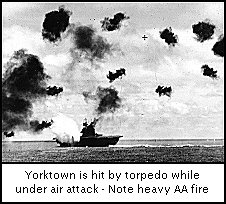
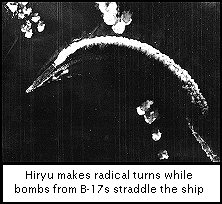 |
|
| 1530 |
Enterprise commences launch of a
strike force of 24 dive bombers |
| 1605 |
Hornet launches a strike force of 16
dive bombers |
| 1640 |
Kaga, fires still burning out of
control, was ordered abandoned. |
| 1705 |
Enterprise strike force hits Japanese
carrier Hiryu and battleship. Hiryu is pummeled with bombs and is
burning out of control as the American bombers depart. |
| 1715 | After fighting fires for seven hours,
Akagi was finally abandoned. |
| 1730 | Hornet dive bombers attack Japanese force hitting a battleship and heavy cruiser. The carrier Hiryu is ignored as it was completely engulfed in fire. |
| 1810 |
Twelve B-17s from Oahu made a low level attack on the Japanese "carrier" group. |
| 1913 |
Fires still burning throughout the
ship, Soryu slips beneath the waves. |
| 1920 | The last of Enterprise's and Hornet's
combat air patrols lands as night falls |
| 1925 |
Two massive explosions ripped through
Kaga, tearing her apart. The wreck sank within minutes |
| June 5 | |
| 0230 | The burned out hulk of the Hiryu
finally sinks. |
| 0430 | B-17s from Midway scout for enemy ships |
| 0700 | Twelve Marine dive-bombers launched
from Midway targeting Japanese cruisers |
| 0810 |
Marine dive-bombers, commence attacks
on cruiser - ineffective |
| 0830 |
Eight B-17 make a high altitude bombing run against the cruiser group |
| 1320 | Seven B-17s set out to attack the
remnants of the strike group, contacting a single cruiser 300 miles NW
Midway, which it attacked. |
| 1435 |
Viero takes Yorktown in tow, making 2 knots. |
| 1500 |
Enterprise launches 32 dive bombers intended for the now carrier-less carrier group.. |
| 1510 |
Hornet launches strike force of 26 dive bombers, also targeting the "carrier" group.. |
| 1545 | Five B-17s set out to attack the
remnants of the strike group, contacting a single cruiser 425 miles NW
Midway, which it attacked |
| 1830 |
Enterprise and Hornet groups make
contact with an enemy cruiser and attack it. |
| 2000 |
Enterprise and Hornet recover their
strike groups. |
| June 6 | |
| 0510 | TF16 launches scouts operates west
semi-circle to 200 miles |
| 0645 |
Scouts contacted cruisers Mikuma and
Mogami with 3-4 destroyers 435 miles west of Midway. |
| 0755 | Hornet launches a strike force of 26 dive bombers. |
| 0950 |
Hornet strike force attacks a group of
Japanese cruisers and destroyers. |
| 1045 |
Enterprise launches 34 strike aircraft
at the enemy cruiser force. |
| 1150 |
The Enterprise strike group attacks
Mogami and Mikuma, sinking the later. |
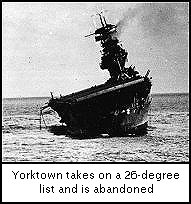
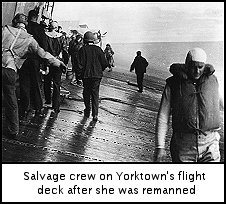 |
|
| June 7 | |
| 1200 | A salvage crew boards Yorktown as
destroyer Hammann is secured alongside to assist. |
| 1335 |
The Japanese submarine I-168, sent by
Yamamoto to track down the crippled Yorktown, found her target and
launched four torpedoes. One torpedo missed, One hit the Hammann,
sinking her almost immediately and the two others struck Yorktown.
Shortly after Hammann had sunk, her depth charges exploded causing more
damage to Yorktown. The list was reduced to 17 degrees but shock damage
was extensive. The salvage crew was removed and would be put back on
board the next morning after contact was made with a fleet salvage tug.
However, at 0330 the next morning, Yorktown started to listing to port
again. By 0500, she turned over on her side and sank. The Battle of
Midway was over. |
